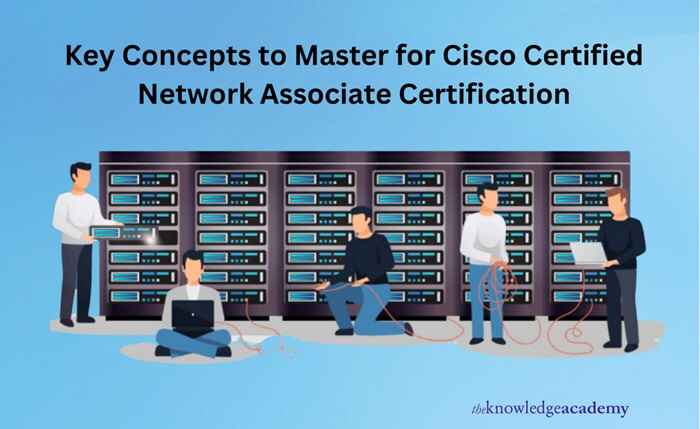The Cisco Certified Network Associate [CCNA] credential opens doors to many opportunities and advancements in IT networking. It’s not only an endorsement of your skill, but also an exploration of the fundamental and sophisticated networking ideas that influence modern corporate culture. Gaining mastery over the essential concepts for the CCNA Certification will enable you to navigate and achieve success in this constantly changing sector, regardless of your experience level in networking.
This blog will explore these crucial subjects in detail, offering an extensive overview to help you prepare for the certification.

Table of Contents
- Networking Fundamentals
- Network Access
- IP Connectivity
- IP Services
- Security Fundamentals
- Automation and Programmability
- Conclusion
1. Networking Fundamentals
A firm grasp of networking principles is the cornerstone of every networking certification. This covers several fundamental ideas:
OSI and TCP/IP Models
Comprehending the TCP/IP protocol suite and the Open Systems Interconnection [OSI] model is essential. With its seven layers, the OSI model offers a framework for understanding how data travels within a network.
- Physical Layer
- Data Link Layer
- Network Layer
- Transport Layer
- Session Layer
- Presentation Layer
- Application Layer
Though seemingly simple, the TCP/IP architecture is the foundation for modern networking and the Internet.
Networking Devices and Their Functions
You must be knowledgeable about many networking devices, including routers, switches, hubs and firewalls. Every device in a network has a distinct function. Switches link devices within a network, routers transport data packets between networks, and firewalls control inbound and outbound network traffic to ensure security.
IP Addressing and Subnetting
IP addressing expertise is essential. You must know the distinctions between IPv4 and IPv6 and how to compute subnets and subnet masks. Subnetting allows networks to be segmented and managed effectively, keeping them organised and secure.
2. Network Access
The following topics are covered in this area about the Physical and Data Link levels of the OSI model:
Ethernet and Switching
Ethernet is the most used technology for Local Area Networks [LAN]. You must be familiar with Ethernet standard protocols and frame structure. Comprehending switching fundamentals like switch forwarding techniques and MAC address tables is crucial.
VLANs
Virtual Local Area Networks or VLANs can divide networks into more manageable, isolated chunks. Lowering broadcast domains increases network performance and security. Network management requires a thorough understanding of VLAN configuration, including inter VLAN routing.
Spanning Tree Protocol [STP]
STP creates a logical topology that is devoid of loops, thereby preventing loops in a network. Maintaining network stability and dependability requires understanding how to configure and troubleshoot STP.
3. IP Connectivity
The Network layer of the OSI model is covered in IP connectivity, which focuses on routing and addressing:
Routing Protocols
It is necessary to comprehend routing protocols to route data packets through networks. Learn these crucial routing protocols:
- RIP [Routing Information Protocol]: Smaller networks employ the RIP distance vector routing protocol.
- EIGRP [Enhanced Interior Gateway Routing Protocol]: Cisco’s EIGRP technology provides faster convergence and scalability.
- OSPF [Open Shortest Path First]: It is a popular link state routing protocol because of its scalability and efficiency.
Static and Dynamic Routing
Both static and dynamic routers ought to be configurable. While dynamic routing uses protocols like OSPF and EIGRP to dynamically alter routes depending on network changes, static routing entails manually creating routes.
IPv6
Being informed about IPv6 is becoming more crucial as IPv4 addresses run out. In addition to introducing new ideas like address autoconfiguration and multicast, IPv6 addresses also have longer address lengths than IPv4 addresses.
4. IP Services
This domain covers several services that run via IP networks:
DHCP
The Dynamic Host Configuration Protocol (DHCP) automates allocating IP addresses to connected devices. Therefore, it is essential to configure and debug DHCP servers and clients.
NAT
Private IP addresses may be mapped to public IP addresses with a Network Address Translation [NAT]. This is essential to preserve public IP addresses and improve security. It’s critical to comprehend how to set up and maintain NAT.
Access Control Lists [ACLs]
It is used to manage the traffic entering and leaving a network. They are essential for carrying out security policies. The system should be able to construct and apply both extended and regular ACLs.
5. Security Fundamentals
One essential component of networking is security. For the CCNA certification, one must be familiar with the following basic security concepts:
Basic Security Measures
This includes establishing secure administration protocols (such as SSH), creating strong passwords, and ensuring networking devices are physically safe.
Port Security
Switch port security helps prevent unwanted devices from connecting to the network. You must be familiar with port security configuration and the ramifications of various violation modes.
Firewalls and VPNs
It is essential to comprehend how Virtual Private Networks [VPNs] and firewalls operate. VPNs enable safe remote network access while firewalls safeguard the network by screening traffic.
6. Automation and Programmability
Automation and programmability are becoming increasingly critical abilities as networks get more complicated:
Basic Automation Concepts
Knowledge of network automation concepts and tools, including Ansible and Python scripting, can significantly improve productivity. Automation allows you to manage and deploy network settings quickly.
Software Defined Networking [SDN]
SDN separates the control plane from the data plane, allowing for more adaptable and effective network administration. Comprehending SDN principles and their application can help maintain one’s competitive edge.
Cisco DNA Centre
Cisco Digital Network Architecture [DNA] Centre is a robust platform for network management. Understanding how to use Cisco DNA Centre for automation, assurance and analytics is becoming increasingly crucial for network professionals.
Conclusion
The extensive Cisco Certified Network Associate certification covers various networking principles. Gaining mastery of these essential concepts will help you pass the CCNA exam and provide you with the information and abilities you need to pursue a lucrative networking career. The CCNA certification offers a strong foundation for any aspiring networking expert, covering everything from basic networking principles to advanced subjects like automation and security.
For more information, visit The Knowledge Academy.

